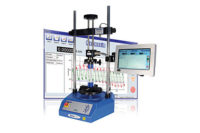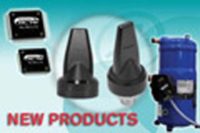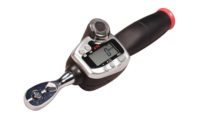Torque testing is an important quality-control step in nearly every manufacturing sector. Properly testing rotary parts for torque with handheld or automated gages can prevent everything from un-openable bottle caps to loose fasteners. Or, in a grave example, if GM properly acted on failed rotational torque tests of ignition switches in some of its mid-2000s models, 13 lives would have been saved.
“Think of all the things in life that you use that require torque to be applied, to either release something or seal something,” says Dr. Patrick Collins, technical director, Mecmesin Ltd. “The lid of your toothpaste or bathroom tap; a bottle of water; your front door knob or lock; that satisfying feeling of the hi-fi volume control with just the right torque response that says ‘quality.’ The release spring on the flip-out car key; the gear-set on your favorite mountain bike; or just the lid of your lunchtime mayonnaise jar—all of these things require torque testing to ensure that they operate within parameters that allow the majority of people to use them.
One of the most common applications is for container lid removal or replacement.
“There is a myriad array of different designs for bottle, jar or container lids. To ensure that each is gripped evenly and correctly for turning requires a specific fixture or ‘mandrel,’” Collins says. “Medical devices use torque testing for measuring the torque required to remove a needle from a syringe. However, we have seen many applications, from measuring fatigue of headset microphone booms, to the torque required to turn a valve on adjustable spectacles.”
Openability is an especially timely topic as Baby Boomers move beyond middle age.
“I think torque testing is becoming more and more important,” he continues. “With aging populations and more automated manufacturing, it’s important to know that containers are sealed well enough to keep contents fresh and secure, but also that they can be opened without excessive effort.”
Other common applications include checking fasteners, medical luer lock mechanisms, torque tool checking and torsion spring testing, among others.
“As consumers’ tolerance for defective products has fallen, and their willingness to publicly shame companies online has risen, we anticipate that manufacturers will continue to invest heavily in testing, which includes torque testing,” says Mark Fridman, Mark-10 director of sales and marketing. “And this trickles down to all phases of the manufacturing process from the raw materials to contract manufacturers and to the contract assemblers.
“So I think with the rise of social media, how people are very willing to bash a company’s products or services, it kind of puts the impetus on companies of all stripes to ensure what they’re shipping is as perfect a product as they can possibly make.”
TORQUE GAGE BASICS
Torque is defined as a force applied to a given distance from an axis of rotation. It’s measured by using manual, motorized or computer-controlled testers. Using these tools, torque is applied by turning the sample either by hand or by a motor-driven sample mount. The measurement takes place between a torque sensor and associated electronics.
Torque is most commonly measured by using static torque sensors or calibrated torque springs, Collins explains. Static torque sensors—used to measure the torque of a bottle cap, for example—are strain-gaged metallic shapes, designed to provide a resistance change based on deformation caused by a twisting motion. In this way, they are the same as load cells used in tensile and compression testing.
“They provide a linear response, which is convenient when conditioning their output and makes them relatively easy to calibrate,” he says.
Continuous torque is measured inline using rotary torque sensors coupled to, say, a driveshaft to measure the torque output of a motor.
Torque instruments that measure static torque consist of a torque sensor, some conditioning electronics to amplify and filter the sensor output, a display to show the measured torque and other relevant information, such as maximum and minimum torque, and a sample holder, Collins says. Motorized torque testers will also have a motor with associated drive electronics. All instruments have embedded software to control motors and/or interpret the electronic signals generated.
Computer-controlled torque testers, as the name implies, use a regular PC and software to control the torque tester and provide acquisition and analysis functionality.
“Using computer-controlled torque testers ensures optimum repeatability and reliability,” he says.
Handheld gages are common especially in R&D labs where accuracy and repeatability needs are not as stringent as on the assembly floor, says Fridman. For better accuracy and repeatability on the assembly floor, a bench-mounted test stand with a torque sensor and an angle indicator is often preferable.
“When you use a motorized test stand, it helps to ensure that there is consistency from test-to-test,” he adds. “Being able to control the speed is often required to comply with a particular standard or internally developed procedure.”
LOOKING AHEAD
The trend towards automation in every manufacturing and assembly sector is mirrored in torque testing as well.
“Automation has improved testing throughput and the quality of manufactured items,” Fridman says. “Integrating testing and manufacturing has reduced testing bottlenecks, while real-time data can quickly highlight a problem in the manufacturing process.”
And with increased automation comes higher connectability.
“The ability to automate a test where you can program the machine to do a certain sequence of events which could include motion control and then data collection—anything to reduce the operator involvement as much as possible, where they basically just have to push a button (will be in more demand),” Fridman says.
Collins agrees, and says he sees increased demand from manufacturers to integrate automated torque testers.
“By providing interfaces to the outside world via serial, digital and analogue inputs and outputs, torque testers can easily be integrated into such systems,” he says. He adds that trends point towards more wirelessly networked systems. “We’ll probably see more use of mobile applications, so supervisors can see test results as they happen, on their phone or tablet. More sophisticated software will make testing easier, and so making it accessible to more customers. Very low torque applications are becoming more commonplace, which will force innovation in signal filtering and system noise control.”












